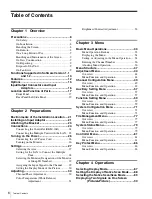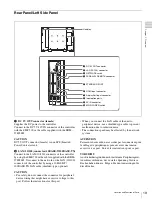
12
Features
Chapt
er 1
O
v
er
v
ie
w
Features
The BVM-E250 is 25-inch Professional Video Monitor.
This is suitable for television stations or video production
houses, where precise image reproduction is required.
The BVM-E250 features OLED panel and
“TRIMASTER
1)
”, which is a new technology developed
for three elements, “accurate color reproduction”,
“precision imaging” and “quality picture consistency,” that
are in demand for professional use. “TRIMASTER”
decreases the viewing difference that occurs due to the
individuality of each panel. Also, the BVM-E250 realizes
the high picture quality and high-trust required for the
master monitor by the color management system with its
wide color gamut device, high-resolution/precise gradation
display, highly accurate signal processing and panel
correction function.
1) TRIMASTER is a trademark of Sony Corporation.
Advantages of OLED panel technology
The OLED panel makes use of an organic material, which
emits light when an electric current is applied. Being self-
emitting, the strength of luminescence can be controlled by
the amount of electric current. This brings about the
following three features:
Quick motion picture response:
The luminescent state of the OLED panel can be changed
instantaneously by changing the current flow in the organic
material. This enables a quick motion picture response and
production of images with minimal blurring and ghosting.
Furthermore, performance for shooting on location is not
influenced by changes in environmental temperature.
High contrast and wide dynamic range:
The OLED panel does not emit light when black signal is
applied to the monitor, enabling a pure black screen to be
displayed. Furthermore, thanks to a wide dynamic range
the panel impressively displays brilliance and clarity of
various sparkling images, such as stars in a night sky
twinkling, night illuminations winking or glass glittering,
etc.
Rich color reproduction:
An OLED panel’s self-luminescence also allows for great
color reproduction across the entire spectrum in practically
any shade or brightness.
Sony’s Super Top Emission
2)
OLED panel
The 25 type full HD (1920 × 1080) OLED panel features
Sony’s Super Top Emission structure. Unlike the
conventional bottom emission structure of TFT, Sony’s
OLED panel can reproduce a crisper image due to high
brightness. Furthermore, a unique microcavity structure
makes RGB primary colors purer and deeper by utilizing
light resonance effects that magnify optimum light wave
lengths and diminish undesired light wave lengths.
The panel’s 10-bit driver enables smooth gradation of color
shading.
2) “Super Top Emission” is a trademark that represents the OLED
technology of Sony Corporation.
12-bit precision display engine for professional
use
The panel is equipped with a unique signal process engine
developed for the professional use monitor. This engine
incorporates 12-bit output accuracy at each process, and
provides a high-quality I/P conversion algorithm, scaling
processing, panel driving and a highly accurate color
management system.
Multi color space
The Sony’s unique OLED panel with a wide color gamut
and color management system which uses the unique 3D
LUT (Look Up Table) reproduces the color space that
complies with the broadcast standard ITU-R BT.709, EBU
and SMPTE-C accurately. A wider color space
3)
allows
digital cinema reproductions.
3) The RGB chromaticity of SMPTE RP 431-2 is not covered in full.
High-quality I/P conversion processing
A high-quality picture near the original one, in which
jagged lines and conversion errors are decreased by
detecting the feature of the picture inside the subdivided
block and processing properly, is reproduced.
The signal delay is decreased by judging the animation or
still picture from the past video signal. Film cadence
processing, which converts the signal composed of 2-2·2-
3·2-3-3-2 pull down to the I/P signal closely following the
original, is also selectable.
Interlace display mode
The interlace signal is displayed as the interlace picture by
inserting the black line without I/P conversion processing.
A picture faithful to the original signal and with the same
feel as a CRT is gained.
For setting the display, see “Selecting Display Mode” on
page 87.
Available to a multi signal format
The monitor supports various input signals such as 720 ×
576/50i to 1920 × 1080/50P, 60P, digital cinema (D-Cine)
2048 × 1080/24P and variable computer signals up to
1920 × 1080. The 3G/HD/SD-SDI inputs, HDMI
4)
and
DisplayPort
5)
(HDCP correspondence) inputs, and four
option ports are equipped for the standard interface. If you
install optional input adaptors, the monitor expands inputs
of 3G-SDI, HD-SDI or SD-SDI, and supports Dual-link
HD-SDI, RGB, YPbPr, Y/C, and composite signal inputs.
4) HDMI, the HDMI logo and High-Definition Multimedia Interface are
trademarks or registered trademarks of HDMI Licensing, LLC.













































